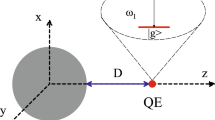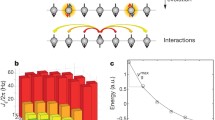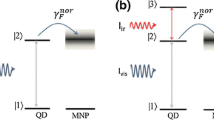Abstract
We study quantum correlations dynamics of two identical V-type quantum systems initially prepared in an extended Werner-like state, where each one independently interacts with a plasmonic nanostructure. Each V-type system can be decomposed as a two-level system with an additional third external level acting as an “umbrella level.” As the plasmonic nanostructure, we use a two-dimensional array of metal-coated dielectric nanoparticles. For the calculations, we combine quantum dynamics calculations using the density matrix equations and classical electromagnetic calculations. In order to describe the entanglement, we use the measure of entanglement of formation, while we use quantum discord to describe the total quantum correlations of our composite system. We find that the presence of the plasmonic nanostructure leads to high suppression of spontaneous emission rates along with a high degree of quantum interference. These phenomena affect the evolution of both entanglement and quantum discord, while they significantly prolong their dynamics.








Similar content being viewed by others
References
Horodecki, R., Horodecki, P., Horodecki, M., Horodecki, K.: Quantum entanglement. Rev. Mod. Phys. 81, 865 (2009)
Nielsen, M.A., Chuang, I.L.: Quantum Computation and Quantum Information. Cambridge University Press, Cambridge (2000)
Breuer, H.-P., Petruccione, F.: The Theory of Open Quantum Systems. Oxford University Press, Oxford (2002)
Yu, T., Eberly, J.H.: Finite-time disentanglement via spontaneous emission. Phys. Rev. Lett. 93, 140404 (2004)
Yu, T., Eberly, J.H.: Sudden death of entanglement. Science 323, 598 (2009)
Franco, R.Lo, Bellomo, B., Maniscalco, S., Compagno, G.: Dynamics of quantum correlations in two-qubit systems within non-Markovian environments. Int. J. Mod. Phys. B 27, 1345053 (2013)
Horodecki, M., Horodecki, P., Horodecki, R.M., Oppenheim, J., Sen(De), A., Sen, U., Synak-Radtke, B.: Local versus nonlocal information in quantum-information theory: formalism and phenomena. Phys. Rev. A 71, 062307 (2005)
Bennett, C.H., DiVincenzo, D.P., Fuchs, C.A., Mor, T., Rains, E., Shor, P.W., Smolin, J.A., Wootters, W.K.: Quantum nonlocality without entanglement. Phys. Rev. A 59, 1070 (1999)
Ollivier, H., Zurek, W.H.: Quantum discord: a measure of the quantumness of correlations. Phys. Rev. Lett. 88, 017901 (2001)
Henderson, L., Vedral, V.: Classical, quantum and total correlations. J. Phys. A 34, 6899 (2001)
Wang, B., Xu, Zhen-Yu., Chen, Ze-Qian, Feng, M.: Non-Markovian effect on the quantum discord. Phys. Rev. A 81, 014101 (2010)
Fanchini, F.F., Werlang, T., Brasil, C.A., Arruda, L.G.E., Caldeira, A.O.: Non-Markovian dynamics of quantum discord. Phys. Rev. A 81, 052107 (2010)
Zhang, P., You, B., Cen, L.-X.: Long-lived quantum coherence of two-level spontaneous emission models within structured environments. Optics Lett. 38, 3650 (2013)
Wang, J., Zhang, H., Zhang, Y., Zhang, L., Huang, T., Sun, S., Zhang, H.-Z.: Dynamics of quantum discord in photonic crystals. Opt. Commun. 285, 2961 (2012)
Iliopoulos, N., Terzis, A.F., Yannopapas, V., Paspalakis, E.: Two-qubit correlations via a periodic plasmonic nanostructure. Ann. Phys. 365, 38 (2016)
Gonzalez-Tudela, A., Martin-Cano, D., Moreno, E., Martin- Moreno, L., Tejedor, C., Garcia-Vidal, F.J.: Entanglement of two qubits mediated by one-dimensional plasmonic waveguides. Phys. Rev. Lett. 106, 020501 (2011)
Martin-Cano, D., Gonzalez-Tudela, A., Martin-Moreno, L., Garcia-Vidal, F.J., Tejedor, C., Moreno, E.: Dissipation-driven generation of two-qubit entanglement mediated by plasmonic waveguides. Phys. Rev. B 84, 235306 (2011)
Xu, J., Al-Amri, M., Yang, Y., Zhu, S.-Y., Zubairy, M.S.: Entanglement generation between two atoms via surface modes. Phys. Rev. A 84, 032334 (2011)
He, Y., Zhu, K.-D.: Strong coupling among semiconductor quantum dots induced by a metal nanoparticle. Nanosc. Res. Lett. 7, 95 (2012)
Gonzalez-Tudela, A., Martin-Cano, D., Moreno, E., Martin-Moreno, L., Garcia-Vidal, F.J., Tejedor, C.: Exploring qubit-qubit entanglement mediated by one-dimensional plasmonic nanowaveguides. Phys. Stat. Solidi C 9, 1303 (2012)
Susa, C.E., Reina, J.H., Sanchez-Soto, L.L.: Correlations in emitters coupled to plasmonic waveguides. J. Phys. B: At. Mol. Opt. Phys. 46, 224022 (2013)
He, Q.-L., Xu, J.-B., Yao, D.-X.: Mediating and inducing quantum correlation between two separated qubits by one-dimensional plasmonic waveguide. Quant. Inf. Proc. 12, 3023 (2013)
Liu, S.-P., Li, J.-H., Yu, R., Wu, Y.: Generation of long-time maximum entanglement between two dipole emitters via a hybrid photonic-plasmonic resonator. Phys. Rev. A 87, 042306 (2013)
Lee, C., Tame, M., Noh, C., Lim, J., Maier, S.A., Lee, J., Angelakis, D.G.: Robust-to-loss entanglement generation using a quantum plasmonic nanoparticle array. New J. Phys. 15, 083017 (2013)
Susa, C.E., Reina, J.H., Hildner, R.: Plasmon-assisted quantum control of distant emitters. Phys. Lett. A 378, 2371 (2014)
Hou, J., Slowik, K., Lederer, F., Rockstuhl, C.: Dissipation-driven entanglement between qubits mediated by plasmonic nanoantennas. Phys. Rev. B 89, 235413 (2014)
Nerkararyan, K.V., Bozhevolnyi, S.I.: Entanglement of two qubits mediated by a localized surface plasmon. Phys. Rev. B 92, 045410 (2015)
Gangaraj, S.A.Hassani, Nemilentsau, A., Hanson, G.W., Hughes, S.: Transient and steady-state entanglement mediated by three-dimensional plasmonic waveguides. Opt. Express 23, 22330 (2015)
Yang, W.-L., An, J.-H., Zhang, C.-J., Chen, C.-Y., Oh, C.H.: Dynamics of quantum correlation between separated nitrogen-vacancy centers embedded in plasmonic waveguide. Sci. Rep. 5, 15513 (2015)
Otten, M., Shah, R.A., Scherer, N.F., Min, M., Pelton, M., Gray, S.K.: Entanglement of two, three, or four plasmonically coupled quantum dots. Phys. Rev. B 92, 125432 (2015)
Zeng, X., Liao, Z., Al-Amri, M., Zubairy, M.S.: Controllable waveguide via dielectric cylinder covered with graphene: tunable entanglement. Europhys. Lett. 115, 14002 (2016)
Hu, Z.-D., Liang, X., Wang, J., Zhang, Y.: Quantum coherence and quantum correlation of two qubits mediated by a one-dimensional plasmonic waveguide. Opt. Express 24, 10817 (2016)
Otten, M., Larson, J., Min, M., Wild, S.M., Pelton, M., Gray, S.K.: Origins and optimization of entanglement in plasmonically coupled quantum dots. Phys. Rev. A 94, 022312 (2016)
Iliopoulos, N., Terzis, A.F., Yannopapas, V., Paspalakis, E.: Prolonging entanglement dynamics near periodic plasmonic nanostructures. Phys. Rev. B 96, 075405 (2017)
Dumitrescu, E., Lawrie, B.: Antibunching dynamics of plasmonically mediated entanglement generation. Phys. Rev. A 96, 053826 (2017)
Hensen, M., Heilpern, T., Gray, S.K., Pfeiffer, W.: Strong coupling and entanglement of quantum emitters embedded in a nanoantenna-enhanced plasmonic cavity. ACS Photon. 5, 240 (2018)
Iliopoulos, N., Thanopulos, I., Yannopapas, V., Paspalakis, E.: Counter-rotating effects and entanglement dynamics in strongly coupled quantum-emitter-metallic-nanoparticle structures. Phys. Rev. B 97, 115402 (2018)
Zhang, F., Ren, J.J., Duan, X.K., Chen, Z., Gong, Q.H., Gu, Y.: Evanescent-field-modulated two-qubit entanglement in an emitters-plasmon coupled system. J. Phys. Condens. Matt. 30, 305302 (2018)
Iliopoulos, N., Thanopulos, I., Yannopapas, V., Paspalakis, E.: Quantum correlations in quantum emitters strongly coupled with metallic nanoparticles. Quantum Inf. Proc. 18, 110 (2019)
Yannopapas, V., Paspalakis, E., Vitanov, N.V.: Plasmon-induced enhancement of quantum interference near metallic nanostructures. Phys. Rev. Lett. 103, 063602 (2009)
Evangelou, S., Yannopapas, V., Paspalakis, E.: Modifying free-space spontaneous emission near a plasmonic nanostructure. Phys. Rev. A 83, 023819 (2011)
Evangelou, S., Yannopapas, V., Paspalakis, E.: Simulating quantum interference in spontaneous decay near plasmonic nanostructures: population dynamics. Phys. Rev. A 83, 055805 (2011)
Evangelou, S., Yannopapas, V., Paspalakis, E.: Transparency and slow light in a four-level quantum system near a plasmonic nanostructure. Phys. Rev. A 86, 053811 (2012)
Carreño, F., Antón, M.A., Yannopapas, V., Paspalakis, E.: Control of the absorption of a four-level quantum system near a plasmonic nanostructure. Phys. Rev. B 95, 195410 (2017)
Wootters, W.K.: Entanglement of formation of an arbitrary state of two qubits. Phys. Rev. Lett. 80, 2245 (1998)
Das, S., Agarwal, G.S.: Protecting bipartite entanglement by quantum interferences. Phys. Rev. A 81, 052341 (2010)
Nair, A.N., Arun, R.: Comment on “Protecting bipartite entanglement by quantum interferences”. Phys. Rev. A 97, 036301 (2018)
Bellomo, B., Franco, R.Lo, Compagno, G.: Non-Markovian effects on the dynamics of entanglement. Phys. Rev. Lett. 99, 160502 (2007)
Bellomo, B., Franco, R.Lo, Maniscalco, S., Compagno, G.: Entanglement trapping in structured environments. Phys. Rev. A 78, 060302 (2008)
Ali, M., Rau, A.R.P., Alber, G.: Quantum discord for two-qubit X states. Phys. Rev. A 81, 042105 (2010)
Luo, S.: Quantum discord for two-qubit systems. Phys. Rev. A 77, 042303 (2008)
Bellomo, B., Franco, R.Lo, Maniscalco, S., Compagno, G.: Entanglement dynamics of two independent qubits in environments with and without memory. Phys. Rev. A 77, 032342 (2008)
Agarwal, G.S.: Anisotropic vacuum-induced interference in decay channels. Phys. Rev. Lett. 84, 5500 (2000)
Kiffner, M., Macovei, M., Evers, J., Keitel, C.H.: Vacuum-Induced Processes in Multilevel Atoms in “Progress in Optics” edited by E. Wolf (Elsevier, Amsterdam, 2010) Vol. 55, p. 85
Author information
Authors and Affiliations
Corresponding author
Additional information
Publisher's Note
Springer Nature remains neutral with regard to jurisdictional claims in published maps and institutional affiliations.
Appendices
Appendix A
Here, we give the expressions for the elements of the composite density matrix \(\rho ^{(2)}_{AB}(t)\). Since the elements of the single-qubit density matrix are given in Eq. (2) and the composite two-qubit density matrix is given by the tensor product \(\rho ^{(2)}_{AB}(t)=\rho ^{(1)}_A(t) \otimes \rho ^{(1)}_B(t)\), following Ref. [49], we take
where \(\rho ^{(2)}_{ij}(t)={\rho ^{(2){^*}}_{ij}}(t)\), with \(i,j={{\mathcal {K}}},{{\mathcal {L}}},{{\mathcal {M}}},{{\mathcal {N}}}\).
Appendix B
Here, we give the details for the derivation of concurrence and QD for a composite system consists by two two-level systems. Since the states given by Eqs. (9) are X-states, the concurrence is given by
with \(C_1=2(|\rho ^{(2)}_{\mathcal{KN}}|-\sqrt{\rho ^{(2)}_{\mathcal{LL}}\rho ^{(2)}_{\mathcal{MM}}})\) and \(C_2=2(|\rho ^{(2)}_{\mathcal{LM}}|-\sqrt{\rho ^{(2)}_{\mathcal{KK}}\rho ^{(2)}_{\mathcal{NN}}})\).
For the initial state \(\rho ^{(2)}_{\varPhi }(0)\) [see Eq. (9a)], the element \(\rho ^{(2)}_{\mathcal{KN}}\) is initially zero and remains zero for every t [49]. Therefore, from Eq. (32), one obtains that \(C_1\) is always negative, leading to the concurrence \(C_\varPhi (t)\) for the initial state \(\rho ^{(2)}_{\varPhi }(0)\) being equal to \(C_2\). Furthermore, for \(0\le a \le 1\) and \(0\le r \le 1\), one can easily prove [6]
Now, when the initial state is \(\rho ^{(2)}_{\varPsi }(0)\) [see Eq. (9b)], the matrix element \(\rho ^{(2)}_{\mathcal{LM}}(t)\) in \(\rho ^{(2)}_{\varPsi }(t)\) is zero at all times; thus, we essentially obtain that the concurrence \(C_\varPsi (t)\) for this initial state equals \(C_1\). From Ref. [6] again, we write
Substituting Eqs. (33)–(34) into Eq. (3), we can also compute EoF for \(\rho _{\varPhi }^{(2)}(0)\) and \(\rho _{\varPsi }^{(2)}(0)\), correspondingly. Because the final analytical expression for EoF is rather complex, we will not present it here.
Writing Eq. (9) in a matrix form, we take
The composite density matrix elements for \(t > 0\) and for the initial states \(\rho ^{(2)}_{\varPhi }(0)\) and \(\rho ^{(2)}_{\varPsi }(0)\) are given [6, 48, 49, 52] as follows: In case of \(\rho ^{(2)}_{\varPhi }(t)\), the matrix elements read
and in case of \(\rho ^{(2)}_{\varPsi }(t)\), the matrix elements read
with \(\rho ^{(2)}_{ij}={\rho ^{(2)}_{ji}}^*\) and all the other elements equal to zero in both cases. So, using these equations for the elements of density matrix, we can derive Eqs. (33)–(34).
Now, we turn our attention to QD. As before, our initial states, Eqs. (9), are X-states, which can be written in the most general form in the basis \({{\mathcal {B}}}=\{ |{{\mathcal {K}}}\rangle \equiv |11\rangle , |{{\mathcal {L}}}\rangle \equiv |10\rangle , |{{\mathcal {M}}}\rangle \equiv |01\rangle , |{{\mathcal {N}}}\rangle \equiv |00\rangle \}\); we thus obtain
We note that \(\sum _{i=1}^4 \rho ^{(2)}_{ii}=1\) holds in the above equation. Here, we assume that all the elements of the matrix are real. By diagonalizing the density matrix \(\rho ^{(2)}_{AB}(0)\), we obtain its eigenvalues, given by
By substituting Eqs. (40)–(43) into Eq. (4), we obtain for the mutual information
In general, a von Neumann measurement on the subsystem B can be written [51] as
with \(\varPi _i=|i\rangle \langle i|\) and \(V\in SU(2)\). After such a measurement, the composite density matrix is given by Eq. (5) with the corresponding probabilities [see Eq. (5)]. A matrix \(V \in SU(2)\) can be written in the form
where \(\varvec{\sigma }=\left\{ \sigma _1, \sigma _2, \sigma _3 \right\} \) with the Pauli matrices \(\sigma _i\), (\(i=1,2,3\)) and \(t, y_1, y_2, y_3\) being real numbers, for which \(t^2+y_1^2+y_2^2+y_3^2=1\) holds. Equation (46) thus implies that three of the four parameters are independent taking values in the interval \([-1,1]\). The most general way to write a X-structured state is given [51] by
where after some algebra, we can rewrite it as [50]
where all the coefficients are real numbers, \(d_1=c_3+a_3+b_3\), \(d_2=-c_3+a_3-b_3\), \(d_3=-c_3-a_3+b_3\) and \(d_4=c_3-a_3-b_3\). Now, using the elements of the composite density matrix of Eq. (39), we have: \(a_3=\rho ^{(2)}_{\mathcal{KK}}+\rho ^{(2)}_{\mathcal{LL}}-\rho ^{(2)}_{\mathcal{MM}}-\rho ^{(2)}_{\mathcal{NN}}\), \(b_3=\rho ^{(2)}_{\mathcal{KK}}+\rho ^{(2)}_{\mathcal{MM}}-\rho ^{(2)}_{\mathcal{LL}}-\rho ^{(2)}_{\mathcal{NN}}\), \(c_3=\rho ^{(2)}_{\mathcal{KK}}+\rho ^{(2)}_{\mathcal{NN}}-\rho ^{(2)}_{\mathcal{LL}}-\rho ^{(2)}_{\mathcal{MM}}\), \(c_1=2(\rho ^{(2)}_{\mathcal{LM}}+\rho ^{(2)}_{\mathcal{KN}})\) and \(c_2=2(\rho ^{(2)}_{\mathcal{LM}}-\rho ^{(2)}_{\mathcal{KN}})\).
In order to evaluate the matrix \(\rho ^{(2)}_{AB_i}\) of Eq. (5), with \(i=0,1\), we write the projective measurement in the form of Eq. (45), starting from Eq. (5) and following the procedure given in Ref. [51], we obtain that
where we have used the unit vector \(\mathbf {z}=(z_1,z_2,z_3)\) as defined in Ref. [51], \(z_1=2(-ty_2+y_1y_3)\), \(z_2=2(ty_1+y_2y_3)\) and \(z_3=t^2+y_3^2-y_1^2-y_2^2\). Now, taking the trace of Eqs. (49) and (50), we find the probabilities
By diagonalizing Eqs. (49) and (50), we obtain their eigenvalues. Rewriting the probabilities of Eqs. (51) and (52) using the density matrix elements, we have \(p_0=(\rho ^{(2)}_{\mathcal{KK}}+\rho ^{(2)}_{\mathcal{MM}})k+(\rho ^{(2)}_{\mathcal{LL}}+\rho ^{(2)}_{\mathcal{NN}})l\) and \(p_1=(\rho ^{(2)}_{\mathcal{KK}}+\rho ^{(2)}_{\mathcal{MM}})l+(\rho ^{(2)}_{\mathcal{LL}}+\rho ^{(2)}_{\mathcal{NN}})k\), and finally, one obtains the eigenvalues of \(\rho ^{(2)}_{AB_0}\) and \(\rho ^{(2)}_{AB_1}\) as
respectively, where the parameters \(\theta \) and \(\theta ^\prime \) are provided by
and \(\varTheta =4\left[ ((\rho ^{(2)}_{\mathcal{LM}})^2+(\rho ^{(2)}_{\mathcal{KN}})^2)(n+m)+2\rho ^{(2)}_{\mathcal{LM}}\rho ^{(2)}_{\mathcal{KN}}(n-m) \right] \). The k, l, m, n parameters used above are given by
Using \(t^2+y_1^2+y_2^2+y_3^2=1\) and \(t, y_1, y_2, y_3 \in [-1,1]\), we derive the following useful relations: \(k+l=1\), \(k-l=z_3\), \(4m=z_2^2\) and \(4n=z_1^2\). Thus, we have: \(k, l \in [0,1]\) and \(m, n \in [0,1/4]\). So, the three out of four parameters are independent. (We choose k, l and m to be independent following Ref. [50].)
Now, using the eigenvalues of the matrices \(\rho ^{(2)}_{AB_0}\) and \(\rho ^{(2)}_{AB_1}\) [see Eqs. (53) and (54), respectively], we can finally compute the corresponding von Neumann entropies. Thus, we obtain
The quantum conditional entropy in Eq. (7) can be thus written as
and as a result, the classical correlation of our system is given by
Therefore, in order to compute the classical correlation of our system, we need to minimize \(S(\rho ^{(2)}_{AB} | \{ \varPi ^B_i \})\) given by Eq. (60); subsequently, we can obtain the QD.
In order to minimize Eq. (60), we follow the procedure of Ref. [50]. Initially, we observe that Eq. (60) is symmetric under the interchange of the parameters \(k \leftrightarrow l\). Thus, Eq. (60) is an even function of \((k-l)\) and as a result, it has endpoints for \(k=l=1/2\) and \(k=0\), \(l=1\) (or \(k=1\), \(l=0\) since it is symmetric under \(k \leftrightarrow l\)). From Eqs. (57), we find that \(t=y_3=0\) (or \(y_1=y_2=0\)) is required at the endpoint \(k=0\), \(l=1\) (or \(k=1\), \(l=0\)). This fact implies that also \(m=n=0\) holds at these points. In case of \(k=l=1/2\), we find that the parameters \(\theta \) and \(\theta ^\prime \) become equal (\(\theta =\theta ^\prime \)) and as a result, this leads to \(S(\rho ^{(2)}_{AB_0})=S(\rho ^{(2)}_{AB_1})\), and the minimization of \(S(\rho ^{(2)}_{AB} | \{ \varPi ^B_i \})\) simply requires the minimization of \(S(\rho ^{(2)}_{AB_0})\) (or \(S(\rho ^{(2)}_{AB_1})\)). Moreover, \(\varTheta \) depends linearly on the parameters m and n and as a result, it takes its extreme values at the endpoints of these parameters, i.e., for \(m=0, 1/4\) and \(n=0, 1/4\). So, in this way, the maximum classical correlations of our composite system as well as all its quantum correlations can be computed at last.
Rights and permissions
About this article
Cite this article
Domenikou, N., Iliopoulos, N., Terzis, A.F. et al. Preservation of entanglement and quantum correlations next to periodic plasmonic nanostructures. Quantum Inf Process 18, 362 (2019). https://doi.org/10.1007/s11128-019-2471-7
Received:
Accepted:
Published:
DOI: https://doi.org/10.1007/s11128-019-2471-7




